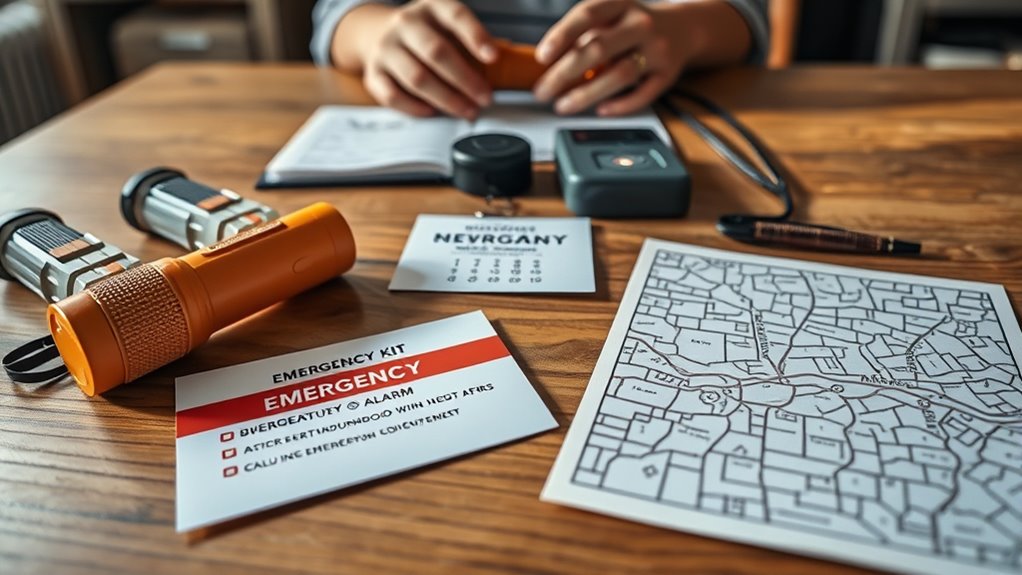To prepare your deafblind household for emergencies, set up tactile, vibratory, and olfactory alert systems to detect danger early. Develop clear communication methods using tactile cues and signals that everyone is familiar with, and store emergency tools within easy reach and labeled by touch. Incorporate technology like haptic feedback devices to improve alerts, and create a detailed emergency plan with regular practice. Continuing with this guide will help you strengthen your safety strategies even further.
Key Takeaways
- Develop a personalized emergency plan using tactile signals, visual labels, and specific touch cues tailored to the household’s needs.
- Install vibratory alert systems and sensory feedback devices to provide real-time emergency notifications.
- Position emergency tools with tactile labels and ensure easy access to essential items in the home.
- Practice regular emergency drills incorporating tactile cues, signals, and communication strategies.
- Establish clear communication methods with caregivers, neighbors, or support networks for quick assistance during crises.

Living without sight and hearing presents unique challenges when it comes to emergency situations, but with proper planning, you can guarantee your safety and well-being. One of the key aspects to consider is how your sensory adaptation influences your perception of danger. Since you rely heavily on tactile, vibrational, and sometimes olfactory cues, it’s crucial to fine-tune these senses to detect early warning signs. For instance, installing vibratory alert systems or tactile warning devices can help you sense emergencies like fire alarms or gas leaks. These adaptations ensure you’re alerted promptly, even when traditional signals are ineffective. Additionally, developing effective communication strategies with caregivers, family members, or neighbors is vital. Establishing a system of signals, tactile cues, or personalized alerts allows you to receive critical information quickly. For example, you might use a specific touch pattern or a physical signal to indicate danger or the need for assistance, ensuring you’re not left guessing during an emergency.
Planning your environment is equally important. Arrange your home so that emergency tools—like fire extinguishers, first aid kits, and communication devices—are within easy reach and marked with tactile labels. This way, you can identify and access essential items even without sight or hearing. Practice regularly with your trusted contacts, so they know how to communicate with you effectively during a crisis. This rehearsal helps reinforce your communication strategies and makes the response more instinctive. Think about technology that integrates sensory adaptation, such as vibrating wristbands or haptic feedback devices, which can transmit alerts directly to you. These tools serve as a crucial link, ensuring you receive critical warnings in real time. Recognizing the importance of specialized devices can significantly improve emergency response for deafblind individuals.
You should also develop a detailed emergency plan tailored to your unique needs. Include clear steps for evacuating or seeking shelter, and make sure your emergency contacts are aware of your specific communication methods. Creating a thorough, written plan that incorporates tactile cues and sensory signals can be a lifesaver, especially during high-stress situations. Remember, the goal is to make your environment as predictable and accessible as possible, reducing confusion and delays in responding to emergencies. With thoughtful sensory adaptation and well-practiced communication strategies, you can turn potential vulnerabilities into manageable safety measures. This proactive approach not only increases your chances of staying safe but also empowers you to respond confidently when emergencies occur.
Frequently Asked Questions
How Can I Find Local Emergency Services Trained for Deafblind Individuals?
To find local emergency services trained for deafblind individuals, start by contacting your city or county’s emergency contacts and ask if they have specialized training for deafblind people. You can also reach out to local organizations that support deafblind communities—they often have partnerships with emergency responders. Additionally, search online for agencies with certifications or programs focused on serving deafblind populations, ensuring you get the help you need during emergencies.
What Specific Communication Tools Are Recommended During Emergencies?
Think of emergency communication tools as your lifelines in chaos. You should use visual alert systems like flashing lights or vibrating alarms to catch your attention instantly. Tactile communication tools, such as vibrating pagers or tactile signage, help convey urgent messages through touch. Combining these tools guarantees you stay informed and safe when seconds count, turning emergency response into a dance where every step is clear and synchronized.
How Do I Create an Accessible Emergency Alert System at Home?
To create an accessible emergency alert system at home, start by integrating sign language alerts and tactile notification systems. Install visual alarms with flashing lights for visual cues, and use vibrating devices or wearable tactile alerts to notify you of emergencies. Confirm these tools are connected to your existing alarm system for quick alerts. Practice regularly to familiarize yourself with the signals, ensuring you respond swiftly during emergencies.
Are There Government Programs Supporting Deafblind Emergency Preparedness?
You should explore government grants that support deafblind emergency preparedness, as they can help fund specialized resources. These programs often provide funding for disaster kits tailored to your needs, including tactile alerts and accessible communication tools. By applying for such grants, you can improve your safety measures and ensure you’re better prepared for emergencies. Stay informed through local agencies and disability organizations to access these valuable support options.
How Can I Involve Neighbors in Emergency Plans for Deafblind Households?
Think of involving neighbors in your emergency plan as planting a supportive web. You should foster neighbor collaboration by sharing your specific needs and training them on how to assist. Community education is key—organize simple workshops or info sessions to help neighbors understand deafblind challenges. This way, you build trust and ensure they’re prepared to help quickly and effectively when an emergency arises, turning your community into a safety net.
Conclusion
Think of your household as a sturdy ship steering unpredictable waters. With proper emergency preparedness, you become the skilled captain, guiding your crew safely through storms. By planning ahead, you guarantee that every member, deaf or blind, feels confident and secure, no matter the turbulence. Remember, your foresight is the lighthouse that keeps everyone safe, illuminating the path forward even in the darkest night. Stay prepared, and you’ll weather any storm together.











